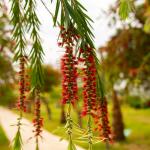
Practical Guide to Drought-Resistant Gardening in Melbourne: Conserve Water While Nurturing a Beautiful Landscape
The Basics of Drought-Resistant Gardening
Drought-resistant gardening is a strategy that employs plants and techniques to withstand water scarcity. Contrary to several misconceptions, a drought-resistant garden is not merely a barren terrain filled with cacti or succulents but can host a wide variety of resilient and aesthetically pleasing plants. There are several keys to achieving a successful drought-resistant garden: understanding the local climate, selecting plants specifically adapted to water stress, and smart, efficient watering practices.
These gardens are vital in conserving water, reducing maintenance costs, and providing an enjoyable, thriving natural space. They are designed to withstand dry periods and require less intervention once established, making them more sustainable overall.
Understanding Melbourne's Gardening Climate
Melbourne's unpredictable weather patterns and rain scarcity prepare the ground for a complex gardening climate. Navigating these challenges determines your gardening success and is essential when focusing on water management. Undeniably, the city's local climate impacts plant growth, with particular plant species struggling during the harsh, dry summer months.
Melbourne experiences variable rainfall throughout the year, with periods of water restrictions prevalent during summer. These environmental elements are significant factors influencing Melbourne's water bills — the more aware you are of these influences, the better prepared you can manage a water-efficient garden.
Selecting the Right Drought-Resistant Plants for Melbourne
In drought-resistant gardening, choosing plants exhibiting hardy characteristics is crucial—for example, deep root systems for accessing underground water reserves, silver or grey foliage that can reflect the sun's rays, and leathery or small leaves that minimise water loss. Some culturally significant plants for Melbourne include the Australian Bottlebrush (Callistemon), which is known for its vibrant red flowers, the Kangaroo Paw (Anigozanthos) with its distinctive paw-shaped flowers, and the towering Eucalyptus tree, all of which are known for their hardiness and visual appeal.
Ensuring that these plants thrive and adapt to their new environment goes beyond the simple act of planting. It requires a deep understanding of the plant's individual care instructions, from the appropriate amount of sunlight exposure to the optimal watering schedule.
Techniques for Water Conservation in Your Garden
Water conservation is integral to successful drought-resistant gardening. Implementing pragmatic steps like collecting and storing rainwater through rainwater tanks, using mulch to reduce surface evaporation and slow weed growth, and setting up an effective and water-efficient irrigation system such as drip irrigation can drastically increase your gardens' water efficiency.
Another important aspect involves amending your garden soil to improve its water retention capacity. This can be achieved by incorporating organic matter—nutrient-rich compost or coir peat, for example—that improves the soil's texture and fertility and increases its capacity to hold water and nutrients, reducing the need for frequent watering.
Maintaining Your Drought-Resistant Garden
Maintaining a garden involves more than just regular watering and the occasional snip-and-trim. For a drought-resistant garden, watchful care involves:
- Identifying and managing common pests and diseases.
- Employing organic or low-impact pesticides when necessary.
- Regular pruning to encourage healthy growth and shape.
- Employing fertilisation methods focussed on retaining and recycling nutrients within the garden ecosystem.
Moreover, an effective plant care routine should involve regular health checks of your garden, paying particular attention to signs of stress among your plants so you can manage these issues early and avoid significant losses.
Conclusion
By adopting a drought-resistant approach to gardening, one can readily embrace and overcome Melbourne's challenging climate. Through the understanding of this highly efficient gardening style, the strategic selection of hardy plants, the employment of tried and tested water conservation techniques, and dedicated garden maintenance, a resilient and vibrant garden can thrive within the Melbourne climate—even amid water restrictions.
Such practices bear fruit for your personal landscape and contribute vital efforts towards environmental stewardship, mitigating the overuse of Melbourne's water reserves. Redefining what it means to harness a green thumb in Melbourne, the journey to creating your drought-resistant garden can commence today.



